







What Happened to Keely's Work
After Keely's death in November 1898 his machines and papers were packed and sent to Thomas Burton Kinraide in Boston.
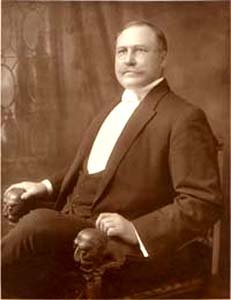 Kinraide had been a friend of Keely's and was well acquainted with Keely's work. He was an electrical engineer with several patents to his name, a thriving business with high tension coils of his own design that were used in X-ray equipment and sold in many countries. He had an excellent reputation. He also had his own research laboratory in Boston and appears to have been a prominent citizen.
On the 4th of January 20 boxes with the papers and machines arrived in Boston for his evaluation, an event that was duly noted in the press.
Kinraide had been a friend of Keely's and was well acquainted with Keely's work. He was an electrical engineer with several patents to his name, a thriving business with high tension coils of his own design that were used in X-ray equipment and sold in many countries. He had an excellent reputation. He also had his own research laboratory in Boston and appears to have been a prominent citizen.
On the 4th of January 20 boxes with the papers and machines arrived in Boston for his evaluation, an event that was duly noted in the press.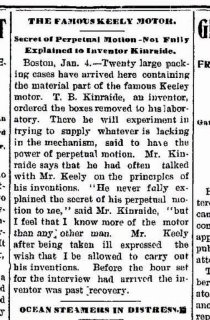 Shortly thereafter the exposure of Keely's Fraud was published a move that was openly criticised by Kinraide. I cannot find out what it was that Kinraide said, but it must have been quite severe to force Ransom Bridge, who was evidently involved in the exposure to go to the press and offer an explanation in answer to Kinraide's criticism. The attached clipping is dated Jan 30th.
Shortly thereafter the exposure of Keely's Fraud was published a move that was openly criticised by Kinraide. I cannot find out what it was that Kinraide said, but it must have been quite severe to force Ransom Bridge, who was evidently involved in the exposure to go to the press and offer an explanation in answer to Kinraide's criticism. The attached clipping is dated Jan 30th.
 About a week later an article was published noting that Kinraide had raised a number of concerns with the directors regarding the exposure and that two directors would come to Boston to discuss matters.
About a week later an article was published noting that Kinraide had raised a number of concerns with the directors regarding the exposure and that two directors would come to Boston to discuss matters.
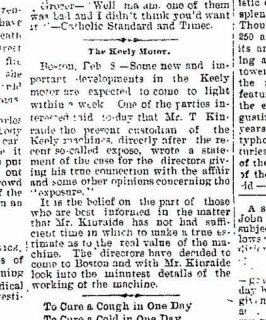 The next clippings, one undated and one dated May 7th, report that Kinraide had distanced himself from the project and would send all the material he had received back to the company.
The next clippings, one undated and one dated May 7th, report that Kinraide had distanced himself from the project and would send all the material he had received back to the company.
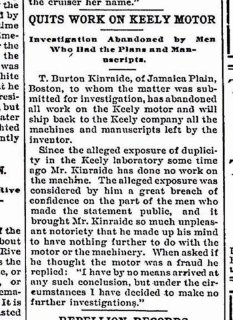
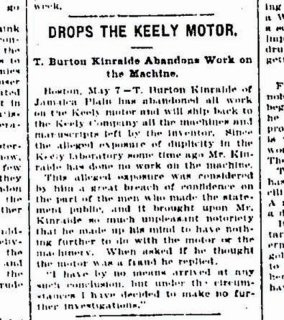 It would appear that Kinraide did not want to risk his reputation and his thriving business by being associated with what had become a major scandal.
He evidently did what he had said for nothing more is heard of him in connection with the Keely affair as it would have been had he kept what was clearly not his property.
The newspaper clippings and photograph published here come from Jeff Behary who has done a lot of excellent research on Kinraide and his achievements.
It would appear that Kinraide did not want to risk his reputation and his thriving business by being associated with what had become a major scandal.
He evidently did what he had said for nothing more is heard of him in connection with the Keely affair as it would have been had he kept what was clearly not his property.
The newspaper clippings and photograph published here come from Jeff Behary who has done a lot of excellent research on Kinraide and his achievements.
More on this amazing man can be found on Jeff's site:
The Turn Of The Century Electrotherapy Museum
Thanks Jeff.
After that nothing more is heard about the 20 boxes except some rumour that they had been shipped to London.
This is perfectly believable since Clara Bloomfield-Moore had an obvious claim on them and she was resident in London at the time.
From there they would have been locked up by the Theosophical Society on the direction of Annie Besant as being too dangerous for public disclosure. The society would have also collected by one means or another any other original work by Keely they could lay their hands on. They must have done an excellent job world wide for there is hardly anything left.
 At that time Annie Besant was the well established head of the organisation. In spite of her cute name and her innocent looks she was high spirited, pragmatic and radical in her views and very effective in everything she did. Totally ruthless when it came to her convictions she used her position in the Theosophical Society to the limit.
At that time Annie Besant was the well established head of the organisation. In spite of her cute name and her innocent looks she was high spirited, pragmatic and radical in her views and very effective in everything she did. Totally ruthless when it came to her convictions she used her position in the Theosophical Society to the limit.
She was also a fighter, creating India's first political party called the Home Rule League, organised demonstrations, public meetings and political agitations and subsequently spent some time in gaol, locked up by the British for her activities in the independence movement.
Because of a massive outcry, led by, amongst others, Mahatma Ghandi, the British were forced to release her, sparking massive jubilations all over India. She actually was president of India's Congress Party for a year, not bad going for an Irish girl who had avocated home rule for Ireland all her life and had done all she could to foster a similar idea in India.
It is a little known fact that Ghandi was given the title Mahatma, meaning Great Soul, by Annie Besant, a name by which he will be forever known to history. So is the fact that Nehru, India's first Prime Minister was educated by a theosophist tutor.
Annie Besant died in Adyar, India in 1933.
Next Chapter:
SONOLUMINESCENCE
Contact:
Hans von Lieven, copyright
2007





















 At that time Annie Besant was the well established head of the organisation. In spite of her cute name and her innocent looks she was high spirited, pragmatic and radical in her views and very effective in everything she did. Totally ruthless when it came to her convictions she used her position in the Theosophical Society to the limit.
At that time Annie Besant was the well established head of the organisation. In spite of her cute name and her innocent looks she was high spirited, pragmatic and radical in her views and very effective in everything she did. Totally ruthless when it came to her convictions she used her position in the Theosophical Society to the limit.